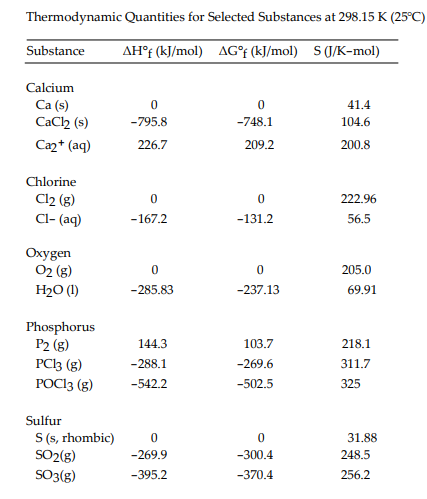4. Calculate the value of ΔSo for the decomposition of POCl3 into its constituent elements, as shown below. 2POCl3(g) → P2(g) + O2(g) + 3Cl2(g)
4. Calculate the value of ΔSo for the decomposition of POCl3 into its constituent elements, as shown below. 2POCl3(g) → P2(g) + O2(g) + 3Cl2(g)
General Chemistry - Standalone book (MindTap Course List)
11th Edition
ISBN:9781305580343
Author:Steven D. Gammon, Ebbing, Darrell Ebbing, Steven D., Darrell; Gammon, Darrell Ebbing; Steven D. Gammon, Darrell D.; Gammon, Ebbing; Steven D. Gammon; Darrell
Publisher:Steven D. Gammon, Ebbing, Darrell Ebbing, Steven D., Darrell; Gammon, Darrell Ebbing; Steven D. Gammon, Darrell D.; Gammon, Ebbing; Steven D. Gammon; Darrell
Chapter18: Thermodynamics And Equilibrium
Section: Chapter Questions
Problem 18.20QP: Given the following information at 25C, calculate G at 25C for the reaction 2A(g)+B(g)3C(g)...
Related questions
Question
4. Calculate the value of ΔSo for the decomposition of POCl3 into its
constituent elements, as shown below. 2POCl3(g) → P2(g) + O2(g) + 3Cl2(g)
5. Calculate the value of ΔSo for the formation of calcium chloride from its
constituent elements, as shown below. Ca(s) + Cl2(g) → CaCl2(s)

Transcribed Image Text:Thermodynamic Quantities for Selected Substances at 298.15 K (25°C)
AH°f (kJ/mol) AG°f (kJ/mol) S (J/K-mol)
Substance
Calcium
Ca (s)
CaCh (s)
41.4
-795.8
-748.1
104.6
Caz+ (aq)
226.7
209.2
200.8
Chlorine
Cl2 (g)
Cl- (aq)
222.96
-167.2
-131.2
56.5
Oxygen
02 (g)
205.0
H2O (1)
-285.83
-237.13
69.91
Phosphorus
Р2 (g)
PC3 (g)
РОС13 (3)
144.3
103.7
218.1
-288.1
-269.6
311.7
-542.2
-502.5
325
Sulfur
S (s, rhombic)
SO2(g)
SO3(g)
31.88
-269.9
-300.4
248.5
-395.2
-370.4
256.2
Expert Solution
This question has been solved!
Explore an expertly crafted, step-by-step solution for a thorough understanding of key concepts.
Step by step
Solved in 3 steps

Knowledge Booster
Learn more about
Need a deep-dive on the concept behind this application? Look no further. Learn more about this topic, chemistry and related others by exploring similar questions and additional content below.Recommended textbooks for you

General Chemistry - Standalone book (MindTap Cour…
Chemistry
ISBN:
9781305580343
Author:
Steven D. Gammon, Ebbing, Darrell Ebbing, Steven D., Darrell; Gammon, Darrell Ebbing; Steven D. Gammon, Darrell D.; Gammon, Ebbing; Steven D. Gammon; Darrell
Publisher:
Cengage Learning

Chemistry
Chemistry
ISBN:
9781305957404
Author:
Steven S. Zumdahl, Susan A. Zumdahl, Donald J. DeCoste
Publisher:
Cengage Learning


General Chemistry - Standalone book (MindTap Cour…
Chemistry
ISBN:
9781305580343
Author:
Steven D. Gammon, Ebbing, Darrell Ebbing, Steven D., Darrell; Gammon, Darrell Ebbing; Steven D. Gammon, Darrell D.; Gammon, Ebbing; Steven D. Gammon; Darrell
Publisher:
Cengage Learning

Chemistry
Chemistry
ISBN:
9781305957404
Author:
Steven S. Zumdahl, Susan A. Zumdahl, Donald J. DeCoste
Publisher:
Cengage Learning


Chemistry: An Atoms First Approach
Chemistry
ISBN:
9781305079243
Author:
Steven S. Zumdahl, Susan A. Zumdahl
Publisher:
Cengage Learning

Chemistry: The Molecular Science
Chemistry
ISBN:
9781285199047
Author:
John W. Moore, Conrad L. Stanitski
Publisher:
Cengage Learning

Chemistry: Principles and Practice
Chemistry
ISBN:
9780534420123
Author:
Daniel L. Reger, Scott R. Goode, David W. Ball, Edward Mercer
Publisher:
Cengage Learning